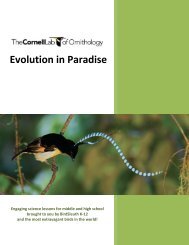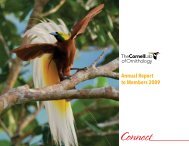National Survey of Fishing, Hunting, and Wildlife ... - All About Birds
National Survey of Fishing, Hunting, and Wildlife ... - All About Birds
National Survey of Fishing, Hunting, and Wildlife ... - All About Birds
You also want an ePaper? Increase the reach of your titles
YUMPU automatically turns print PDFs into web optimized ePapers that Google loves.
Large MSA25%Medium MSA17%Percent <strong>of</strong> Hunters by Residence(Hunter population: 13.7 million)Percent <strong>of</strong> U.S. Population Who Hunted by Residence(Total U.S. population that hunted: 6 percent)Large MSA(1,000,000 or more)Medium MSA(250,000 to 999,999)Small MSA(50,000 to 249,999)Outside MSA3%5%11%Outside MSA20%Percent <strong>of</strong> U.S. Population Who Hunted by Household IncomeLess than $20,000$20,000 to $24,999$25,000 to $29,999$30,000 to $34,999$35,000 to $39,999$40,000 to $49,999$50,000 to $74,999$75,000 to $99,9993%4%5%5%5%7%8%9%Small MSA38%18%Metropolitan <strong>and</strong> NonmetropolitanHuntersAs was the case for fishing, participationrates for hunting were the lowestamong residents <strong>of</strong> the largest metropolitanstatistical areas (MSAs) 1 <strong>and</strong>were the highest among non-MSAresidents. Residents <strong>of</strong> the MSAs with apopulation <strong>of</strong> 1 million or more huntedat a 3 percent rate, which compares to18 percent <strong>of</strong> those who resided outsideMSAs. Furthermore the smaller theMSA the higher the participation rate.The rate among residents <strong>of</strong> MSAs <strong>of</strong>50,000 to 249,999 was 11 percent <strong>and</strong>among residents <strong>of</strong> MSAs with 250,000to 999,999 inhabitants the rate was5 percent.Despite the lower participation ratesamong MSA residents, they still madeup the majority <strong>of</strong> hunters. Over 10.9million hunters were MSA residents,compared to 2.8 million who werenon-metropolitan residents.Household Income <strong>of</strong> HuntersThe participation rate in huntingincreased as household incomeincreased until it reached incomes <strong>of</strong>$100,000 or more. The participationwas highest among those with incomes<strong>of</strong> $75,000 to $99,999 at 9 percent.Participation rates for those whoreported incomes <strong>of</strong> $50,000 to $74,999<strong>and</strong> $100,000 to $149,999 was slightlylower at 8 percent. The participationrate in hunting for household incomes<strong>of</strong> $40,000 to $49,999 was 7 percent.A participation rate <strong>of</strong> 5 percent wasreported for the following four incomegroups: $25,000 to $29,999; $30,000to $34,999; $35,000 to $39,999; <strong>and</strong>$150,000 or more. The lowest participationrate was 3 percent reportedfor household incomes <strong>of</strong> less than$20,000.$100,000 to $149,999$150,000 or more5%8%The majority <strong>of</strong> hunters had householdincomes <strong>of</strong> $50,000 or more.Among hunters who reported income,64 percent had household incomes<strong>of</strong> $50,000 or more, <strong>and</strong> 36 percenthad household incomes <strong>of</strong> less than1See Appendix A for definition <strong>of</strong> metropolitan statisticalarea.30 2011 <strong>National</strong> <strong>Survey</strong> <strong>of</strong> <strong>Fishing</strong>, <strong>Hunting</strong>, <strong>and</strong> <strong>Wildlife</strong>-Associated Recreation U.S. Fish <strong>and</strong> <strong>Wildlife</strong> Service <strong>and</strong> U.S. Census Bureau






